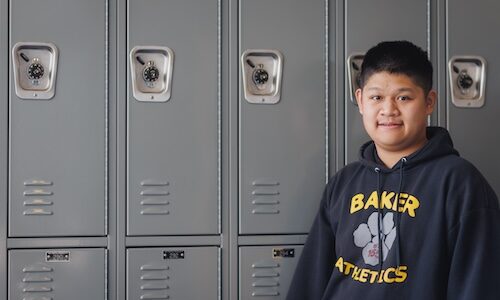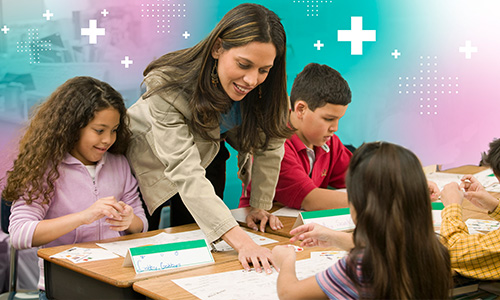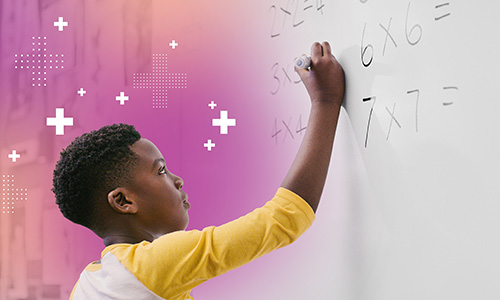
The water disappeared! Or did it? Can water just disappear? And so, the learning of science begins.
Educators and researchers alike recognize that incorporating students’ personal interests into learning is an important motivator. Perhaps a teacher knows of her students’ fascination with magic and asks one student, Mia, to watch a disappearing water magic trick video on YouTube and perform the trick for the class. Mia’s performance can engage students, motivate sense-making of the phenomenon, and offer an empowering experience for a student who may have felt left out of science in the past.
 Image by Megan Kuehl
Image by Megan Kuehl
Research shows that participation improves for middle school girls, urban high school students of color, and elementary students from immigrant families when the learning leverages students’ experiences, questions, and concerns. While a phenomenon like a magic trick makes for an engaging lesson or unit of instruction, how else might educators engage students in scientific learning that potentially lasts a lifetime? One answer lies in the crosscutting concepts.
About the NGSS crosscutting concepts
A Framework for K–12 Science Education from the National Research Council is the foundational document for the Next Generation Science Standards (NGSS). It states that crosscutting concepts provide students with an “organizational framework for connecting knowledge from the various disciplines into a coherent and scientifically based view of the world.” Integrating the various disciplines of science with the help of the crosscutting concepts is an excellent way for students to deeply explore things they care about and feel personally connected to. The NGSS use the framework’s seven crosscutting concepts:
- Patterns
- Cause and effect
- Scale, proportion, and quantity
- Systems and system models
- Energy and matter
- Structure and function
- Stability and change
These seven concepts can be used throughout K–12, and the National Science Teachers Association (NSTA) breaks them down by grade in their crosscutting concepts matrix to help you get an idea of what they might look like in your classroom.
Providing equitable access
In a webinar on the crosscutting concepts, one of the authors of the framework, Helen Quinn, explains that crosscutting concepts are “powerful tools. Kids, all kids, need them because they will help them look at problems in their life and be able to do something about them in constructive ways.” She contends that “the opportunity to practice using the crosscutting concepts in situations where they’re powerful and learn the power is an equity issue.”
Crosscutting concepts are not just for high-achieving students, but for all students, as asserted in the NGSS appendix on the concepts. Unfortunately, students assigned to basic science classes that focus on factual knowledge and lower-order thinking skills may not experience problem-solving techniques using crosscutting concepts. All students need the opportunity to learn the power of crosscutting concepts, through classroom learning and assessment, so they can make sense of their changing world. Let’s examine the four ways you can encourage students’ use of crosscutting concepts as tools for sense-making, drawn from the work of Charles W. (Andy) Anderson et al.:
- Identify productive questions and goals
- Provide rules for sense-making
- Guide the search for evidence
- Support analogical reasoning
1. Identify productive questions and goals
Noticing patterns is often the first step in making sense of an unfamiliar phenomenon. The patterns may lead to an underlying cause and productive questions that can guide and expand students’ thinking, investigation, and research.
Consider Mia’s magic trick. If students put their observations into a data table, they’ll notice patterns start to emerge. What are two ways to group the observations? Which group is puzzling?

Students may wonder: What causes the water to disappear? Where did the water go? What happened inside the cup? And the investigative process begins. This task builds upon the following K–2 concept from the crosscutting concepts matrix:
Cause and effect crosscutting concept: Events have causes that generate observable patterns.
While the disappearing water magic trick activity targets the fifth-grade NGSS performance expectation 5-PS1-2, meaning you are likely doing an activity like this with fifth-graders, “NGSS innovations and instructional materials” explains that performance expectations are endpoints for a grade level or grade band. You can mix and match the dimensions during classroom instruction. Likewise, you may see value in deviating from the grade band. In this instance, by starting with a K–2 crosscutting concept, you can assess your students’ previous exposure to concepts from earlier grades. You may also see value in introducing crosscutting concepts from higher grade bands as appropriate.
Upon reflection on the cause and effect crosscutting concept listed earlier, your fifth-graders may realize that by looking for observable patterns they focused in on what was discrepant and directed their questions toward the cause of that discrepancy. This is a strategy that students can readily repeat with any of the crosscutting concepts when problem solving.
2. Provide rules for sense-making
Consider the question “What causes the water to disappear?” posed earlier. Students who understand energy and matter, as detailed for grades 3–5 in the matrix, will eliminate the claim that the water simply disappeared.
Energy and matter crosscutting concept: Matter flows and cycles can be tracked in terms of the weight of the substance before and after a process occurs. The total weight of the substance does not change. This is what is meant by conservation of matter. Matter is transported into, out of, and within systems.
These students will understand the rule that water is matter and that matter is conserved; matter cannot just disappear. These students will favor the claim that matter either stayed within the cup or was transported out of the cup. They may also recognize that the other questions—“Where did the water go?” and “What happened inside the cup?”—are more productive to investigate than “What causes the water to disappear?”
Upon reflection, students may realize that rules from the crosscutting concepts are useful tools for defining plausible explanations and eliminating implausible ones.
3. Guide the search for evidence
Another way the energy and matter crosscutting concept is useful for sense-making is that it can guide the search for evidence. In this case, students can use the conservation of matter as a tool to trace the movement of matter through the system of the cup. Here’s that crosscutting concept under energy and matter for grades 3–5 in the matrix again, but notice that the focus is on tracking data this time:
Energy and matter crosscutting concept: Matter flows and cycles can be tracked in terms of the weight of the substance before and after a process occurs. The total weight of the substance does not change. This is what is meant by conservation of matter. Matter is transported into, out of, and within systems.
To track where the water poured into the cup goes, students can measure the weight, or mass, of the cups before, during, and after the magic trick, as shown below. (Mia the magician will not allow the students to look inside the cups. She refuses to give away her trick that easily!)

Patterns come into play again, too. Here’s the crosscutting concept for patterns for grades 3–5 in the matrix:
Patterns: Patterns can be used as evidence to support an explanation.
The patterns in the numbers reveal a very different story from what students observed during the magic trick. The patterns in the data provide additional evidence to get them closer to an explanation. The evidence confirms that the water stays in the cup.
Upon reflection, students may realize that by using a crosscutting concept as a lens for guiding the search for evidence, the results can provide insights that deepen their understanding of the phenomenon.
4. Support analogical reasoning
Analogical reasoning involves applying well-understood phenomena to unfamiliar phenomena.
Perhaps your students have already investigated the phenomenon of how sugar seems to vanish in water when they make food for the hummingbird feeder outside your classroom window. From their investigations, they know the final mixture still has the properties of water and have learned that sugar is made of tiny particles they cannot see.
Students can use this knowledge when trying to make sense of what happens in Cup C from Mia’s magic trick. The system of the hummingbird feeder offers a helpful analogy for explaining the interactions of matter within the system of the magician’s cup, especially when students compare the inputs and outputs of the two systems. The crosscutting concepts matrix describes what this looks like for grades 6–8:
Systems and models crosscutting concept: Models can be used to represent systems and their interactions—such as inputs, processes, and outputs—and energy, matter, and information flows within systems.

By comparing the outputs, students can reason that unlike the hummingbird feeder system, the Cup C system creates a new substance with different properties. As students explore the interactions inside the cup further, they will learn the science of chemical reactions. In this particular case, water particles bond with particles of the unknown substance in Cup C, a polymer responsible for the absorbency of diapers. The reaction forms a new substance with new properties that cause it to solidify and stick to the bottom of the cup.
Upon reflection, students may realize that analogical reasoning using phenomena they already understand can be a key strategy for making sense of complex or obscure problems.
In closing
From making informed decisions to understanding current events and global issues, scientific thinking and problem solving are central to all people’s lives. All students, no matter their career path, need the opportunity to learn and practice evidence-based reasoning and sense-making in the classroom and in assessments. When students use the tools of crosscutting concepts in the classroom and reflect on their usefulness, they begin to understand their relevance in their personal experiences outside the classroom. For everyday decision making, students learn to ask questions based on patterns they see, look for the evidence behind potential cause-and-effect relationships, use analogical reasoning in comparisons, and apply rules of science to distinguish reasonable from unreasonable arguments and more.
As educators, we can influence the equity of opportunity for learning life skills like sense-making using evidence. Even a simple phenomenon like a magic trick that incorporates the tools of crosscutting concepts can lead to robust scientific exploration, learning, and problem solving. Students can not only use crosscutting concepts to uncover the science behind a magic trick, but they can learn the magic of scientific thinking, too!







